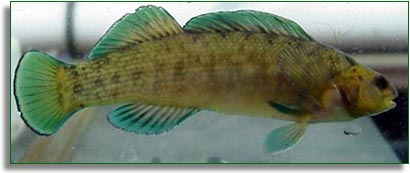|
May 10, 2005
A rare fish that has been on the federal endangered species
list for 17 years is being given a new chance at survival in Tennessee
River tributary where the fish has not been seen since the 1880s.
 |
| Boulder Darter - USFW photo |
Today, 217 young boulder darters, grown in a hatchery, are being released
by professional foresters and scientists into Shoal Creek, which flows
through Lawrence County, Tennessee, and Lauderdale County, Alabama.
Our partnership of public and private organizations may save the rare
boulder darter from extinction, said Sam D. Hamilton, Southeast regional
director for the U.S. Fish and Wildlife Service. Before today, this fish
only existed in the Elk River in Tennessee and Alabama. Now another
population of boulder darters has a chance to gain a foothold in the wild,
and perhaps eventually recover to the point that Endangered Species Act
protection is no longer needed.
The Service is joined in the effort by International Paper (IP), Tennessee
Wildlife Resources Agency, the Alabama Department of Conservation and
Natural Resources, and Conservation Fisheries Inc., (CFI), a non-profit
fish conservation organization based in Knoxville, Tenn., that provided the
young darters.
As part of reintroducing the darters to Shoal Creek, the fish were placed
in bags and then floated in Shoal Creek so they could acclimate to their
new environment before being released. CFI will tag each darter, monitor
the fish population several times a year and document any spawning
behavior.
The boulder darter was listed as endangered in 1988. The only known wild
populations of the boulder darter exist in the Elk River, Giles and Lincoln
Counties, Tenn., and Limestone County, Ala., and in the lower reaches of
Richland Creek, an Elk River tributary. Only three inches in length, the
fish is olive-to-gray-colored. There is evidence, based on historically
available suitable habitat, that boulder darter fish once inhabited
fast-water, rocky habitat in the Tennessee River and its larger tributaries
from the Paint Rock River in Madison County, Ala., downstream to at least
Shoal Creek.
Boulder darter populations originally disappeared from the Tennessee River
system because of poor water quality and the construction of Wilson Dam.
However, as a result of the Clean Water Act and environmental control
measures by public and private organizations, industries and individuals,
the creek’s water quality has greatly improved.
A portion of Shoal Creek adjacent to International Paper forests was
identified as the best site for reintroduction of the fish.
Since 2001, International Paper has been an active partner in preparing to
reintroduce the boulder darter into Shoal Creek. While conducting a survey
of Shoal Creek, CFI identified a shoal adjacent to an area of our
forestlands in southeastern Tennessee as the best habitat for the initial
reintroduction, said David A. Liebetreu, International Paper’s vice
president, Forest Resources. Our IP professional foresters and scientists
were already involved in the propagation effort, so it was a natural step
to reintroduce the fish from the banks of our forestland into the waters
that we help to protect. This is a tribute to our protection of water
quality and an example of our continuing efforts to protect aquatic
biodiversity.
The reintroduced fish are designated as nonessential experimental
populations under the Endangered Species Act. This classification precludes
anyone who accidentally kills or harms the fish from being in violation of
the law, provided that the take occurs as part of an otherwise lawful
activity. Similarly, federal or federally funded projects will not be
required to be altered or stopped to protect these darters.
Non-essential experimental populations are valuable management tools in the
recovery of rare species. Because of the reduced regulatory restrictions on
these populations, this designation on a portion of Shoal Creek provides a
recovery opportunity for the boulder darter that might not otherwise be
realized, said Gary Myers, executive director, Tennessee Wildlife Resources
Agency. It is also providing a partnership opportunity for state and
federal agencies, conservation organizations and industry to work together
toward the common goal of species recovery.
The boulder darter reintroduction is part of a major, cooperative effort to
restore and recover native species in the Tennessee River system. Other
projects have included reintroducing the spotfin chub and three other fish
species into Abrams Creek in Blount County; augmenting boulder darter
populations in the Elk River; and reintroducing the spotfin chub and three
other federally-listed species into the Tellico River.
|